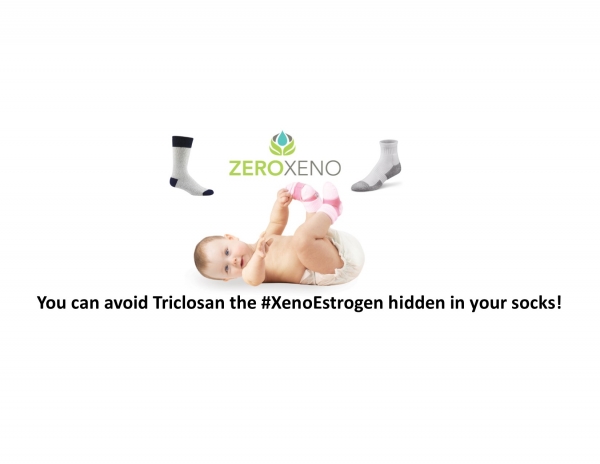Our products are proudly manufactured in Canada and a product of Canada.
Are Xenoestrogens Hidden in Your Socks?
March 23, 2018

Do you know what's in the socks you wear every day? If not, you might want to take a moment to learn how Triclosan a hormone disrupting chemical and environmental toxicant with known estrogenic activity (EA) could be hidden in your hosiery.
Aren't Anti-bacterial Socks a Good Thing?
Now I bet you're thinking, "It can't be true, how could my socks be loaded with xenoestrogens (foreign chemicals that mimic estrogen)?" Luckily, not all socks pose this risk, it's only the anti-bacterial ones. Bare with me for a moment while I explain.
Those of you who regularly read my blogs already understand the dangers associated with Triclosan (the anti-bacterial in your hand sanitizer, toothpaste and hand soap). Studies show Triclosan is linked to liver tumors, hypothyroidism and increased estrogen production that may lead to estrogen dominance and other hormone related issues.
Well, this same chemical may be lurking in your socks. The promise of eternal freshness and anti-bacterial protection sounds like a dream come true right? The truth is you won't find bacteria growing in these brands of socks, but did you ever stop to think why this is true? Triclosan was registered with the US Environmental Protection Agency (EPA) in 1969 as a pesticide and when embedded in your socks allows companies to legally claim their socks are anti-bacterial. Sock manufactures cleverly hide Triclosan under trademark names like BioFresh and Microban.
Being a mother of 4 boys I have often marvel at what they can do to an innocent pair of socks. I must admit I have considered dipping my boys socks in some heavy duty detergents, but to coat their socks in a pesticide to ensure they are fresh and clean seems a bit over the top don't you think!
Barefoot or Bust?
So how does one ensure their socks are xenoestrogen-free? That people should even have to go out of their way to find 'all natural' socks is crazy, but unfortunately it is the reality of the modern world we live in. First, when shopping for socks look for ones that contain a high amount of cotton or another natural fiber. Triclosan adheres best to synthetic fibers due to its chemical, synthetic structure.
Secondly, choose to avoid socks that claim to be anti-bacterial or anti-microbial. This rule of thumb is also best followed when purchasing sandals, clothing and other products that make anti-bacterial claims like children's toys, infant bibs, undergarments, cutting boards etc.
Last but not least, simply go sockless, in the summer of course, after all bare feet are back in style. It's time to get back to the basics and live simpler lives, your health and hormones will thank you.
Join The Zero Xeno Movement today!
by Bonnie Penner
All Zero Xeno (ZX Enterprises Inc.) products are for external use only. All advice and information posted on this website is from personal research and/or experience and is intended for general educational purposes. Our intent is not to diagnose, treat, cure or prevent any disease. The information on our site is not intended to be a substitute for professional medical advice related to specific medical conditions. We cannot diagnose illnesses nor confirm any claim as to therapeutic safety, effectiveness or course of treatment. Always seek the advice of your physician or other qualified health professionals for any concerns regarding your health. Only your physician can provide specific diagnosis and treatments. Please refer to our full Disclaimer for more details.



